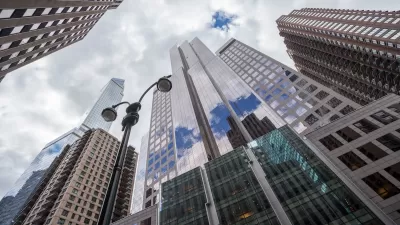When the 807 ft. MetLife Building in Manhattan's Midtown opened half a century ago, it was viewed as an 'assault' on it's iconic neighbor, Grand Central Terminal. However, it was indicative of what the real estate market wanted in the 1960s.
While Grand Central Terminal celebrated it's centennial on Feb. 02 and has received wide attention - with new books, newspaper articles and radio reports, gone relatively unnoticed was the 50-year anniversary of it's massive neighbor - originally known as the Pan Am Building. Ginia Bellafante, who writes the "Big City" column for the New York Times, gives the building's semicentennial the attention it deserves, even if it is not positive.
What is to be marked, really, is a half-century of evinced distaste, though some of it waning under the grip of nostalgia, for a building that existed as an assault on Grand Central Station (sic), its visual foundation bifurcating and marring views of Park Avenue and casting dark shadows on crowded streets beneath it.
Built as the world’s largest corporate structure, with 2.4 million square feet of floor space, the building in its planning phases was known as Grand Central City. The idea was that it would function as a self-sustaining universe — a shopping mall of more than 100,000 square feet. In many ways, the building presaged ...the excesses of the 1980s, both corporate and consumer...
While the Pan Am Building was renamed the MetLife Building in 1981 after it was sold to the Metropolitan Life Insurance Company, "the building was meant to signal the glamorous arrival of the jet age. In 1966, Pan Am began offering rooftop helicopter service to John F. Kennedy International Airport", even if that service only lasted two years.
In contrast to the 1960s, which saw limited public input into planning and resulted in the destruction of New York's original Penn Station and the near-demolition of the now-landmarked 1913 Grand Central Terminal, planning has come full circle as illustrated by the MidTown East plan - "the rezoning of the the area bounded roughly by Fifth and Second Avenues and 39th and 57th Streets". As a result, planning along Park Ave will receive the attention and input from more than just the commercial sector that it received when the initial construction of the Pan Am Building began in 1958.
FULL STORY: BIG CITY: Building High Anxiety

Maui's Vacation Rental Debate Turns Ugly
Verbal attacks, misinformation campaigns and fistfights plague a high-stakes debate to convert thousands of vacation rentals into long-term housing.

Planetizen Federal Action Tracker
A weekly monitor of how Trump’s orders and actions are impacting planners and planning in America.

San Francisco Suspends Traffic Calming Amidst Record Deaths
Citing “a challenging fiscal landscape,” the city will cease the program on the heels of 42 traffic deaths, including 24 pedestrians.

Half of Post-Fire Altadena Home Sales Were to Corporations
Large investors are quietly buying up dozens of properties in Altadena, California, where a devastating wildfire destroyed more than 6,000 homes in January.

Opinion: What San Francisco’s Proposed ‘Family Zoning’ Could Really Mean
Mayor Lurie is using ‘family zoning’ to encourage denser development and upzoning — but could the concept actually foster community and more human-scale public spaces?

Jacksonville Launches First Autonomous Transit Shuttle in US
A fleet of 14 fully autonomous vehicles will serve a 3.5-mile downtown Jacksonville route with 12 stops.
Urban Design for Planners 1: Software Tools
This six-course series explores essential urban design concepts using open source software and equips planners with the tools they need to participate fully in the urban design process.
Planning for Universal Design
Learn the tools for implementing Universal Design in planning regulations.
Gallatin County Department of Planning & Community Development
Heyer Gruel & Associates PA
JM Goldson LLC
City of Camden Redevelopment Agency
City of Astoria
Transportation Research & Education Center (TREC) at Portland State University
Jefferson Parish Government
Camden Redevelopment Agency
City of Claremont



























